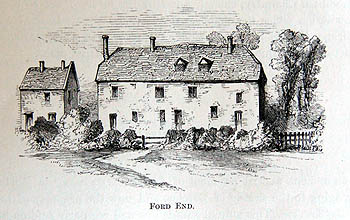Ford End Manor House
![Ford End Manor House about 1910 [X306/92/1]](/CommunityHistories/Biddenham/BiddenhamImages/Ford End Manor House about 1910 [X306-92-1].jpg)
Ford End Manor House about 1910 [ref: X306/92/1]
Forthe End or Ford End House no longer exists. The Bedfordshire Historic Environment Record [HER] contains information on the county’s historic buildings and landscapes and summaries of each entry can now be found online as part of the Heritage Gateway website. The entry for the property [HER 8672] notes that it was demolished around 1960.
The site was once in Biddenham but since 1934 has been part of the Borough of Bedford. It lies some yards east of 92 Old Ford End Road. This area was known into the 20th century as Biddenham Ford End.
In his History of the Hundred of Willey of 1872 William Marsh Harvey stated: “The mansion-house of the Boteler family, called Ford End, about half a mile to the south-east of the village, and, as its name implies, near the river, was at one time appropriated as a workhouse; a portion of the old garden wall yet stands, but few traces now remain of its former splendour” in a note he goes on: “Some old inhabitants, in Archdeacon Tattam’s time [1845-1866], recollected the barrel which was kept full of table beer for the use of all the poor who wished to partake of it, and to which an iron ladle was attached, that they might freely help themselves”.
The Botelers purchased the Manor of Biddenham or Newnham from Sir John Gostwick in 1540 and held it until the death of William Boteler in 1671 leaving three daughters as heirs. The manor was based on the holdings of the Priory of Newnham in Biddenham. Volume III of The Victoria County History for Bedfordshire, published in 1912, relates that the family had been in Biddenham for some time. At the end of 15th century they acquired a capital messuage by marrying into the Kirton family and this must be Ford End Manor House or an earlier building on the same site.
The Victoria County History goes on to say: “Ford End or Kirtons which was the residence of the Botelers from the 15th century, is situated about half a mile to the south-east of the river [sic]. It consists of two rectangular blocks now used as cottages. They are of little architectural interest, the walls being built of coursed rubble washed over, with square, unmoulded openings for the doors and windows. The chimney stacks are brick and the roofs are of tiles. The buildings have undergone many changes, being in the middle of the last century used as a workhouse, and it is impossible to tell the date of the original house or on what plan it was built”.
Some documents in the Trevor-Wingfield archive mention Ford End Manor. One dates to 1566 and is a lease of Forthend House and other properties to William Boteler of Biddenham, son and heir of William Boteler, deceased, from his mother Anne Godwyn of London, widow of Thomas Godwyne, esquire and previously wife of William Boteler. The house was stated to be late in the occupation of James Hardwicke [ref: TW606]. Hardwicke had demised it to William Boteler in 1564 [ref: TW605] having had an original demise himself from Thomas Godwyn the year before.
Another is a mutilated lease of about 1675 from William Boteler and Elizabeth, his wife to Thomas Crosse for three years at an annual rent of £104. Some of the rooms can still be read including a room over the larder called the Doctor’s Chamber, a little room over the bakehouse where John Faldo did something now unreadable! There was also a milk house, a dairy house and two coppers for boiling water, and use of a hog yard for the hogs as well as a warren in Biddenham, the dovehouse and the chamber called The Warrener [ref: TW679].

Ford End Manor House from The History of the Hundred of Willey
List of sources at Bedfordshire Archives:
- TW605: Deed, 1564
- TW606: Lease, 1566
- TW679: Deed, 1670
- X306/92/1: Photograph of Boteler Manor House, Biddenham